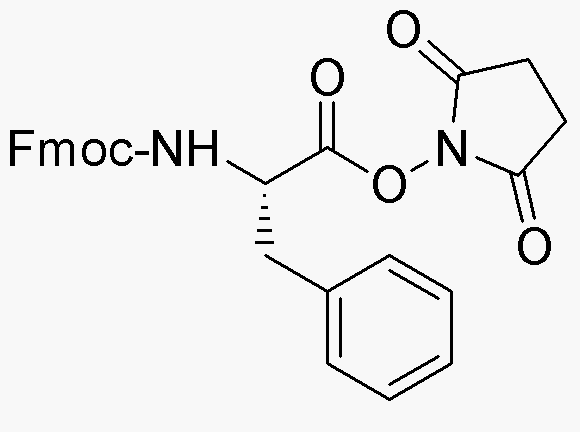Fmoc-L-phenylalanine N-hydroxysuccinimide ester is widely utilized in research focused on:
- Peptide Synthesis: This compound serves as a key building block in the synthesis of peptides, allowing for the introduction of phenylalanine residues. Its stability and ease of use make it a preferred choice for researchers in biochemistry and molecular biology.
- Drug Development: In pharmaceutical research, it is used to create peptide-based drugs. Its ability to facilitate the formation of stable peptide bonds enhances the efficiency of drug design processes.
- Bioconjugation: The compound is effective in bioconjugation applications, where it helps to attach biomolecules to surfaces or other molecules, improving the delivery and efficacy of therapeutic agents.
- Protein Engineering: Researchers utilize this ester in protein engineering to modify proteins, enhancing their functionality and stability for various applications in biotechnology.
- Diagnostic Tools: It plays a role in the development of diagnostic tools by aiding in the creation of peptide-based assays, which can be used for disease detection and monitoring.
Informations générales
Propriétés
Sécurité et réglementation
Applications
Fmoc-L-phenylalanine N-hydroxysuccinimide ester is widely utilized in research focused on:
- Peptide Synthesis: This compound serves as a key building block in the synthesis of peptides, allowing for the introduction of phenylalanine residues. Its stability and ease of use make it a preferred choice for researchers in biochemistry and molecular biology.
- Drug Development: In pharmaceutical research, it is used to create peptide-based drugs. Its ability to facilitate the formation of stable peptide bonds enhances the efficiency of drug design processes.
- Bioconjugation: The compound is effective in bioconjugation applications, where it helps to attach biomolecules to surfaces or other molecules, improving the delivery and efficacy of therapeutic agents.
- Protein Engineering: Researchers utilize this ester in protein engineering to modify proteins, enhancing their functionality and stability for various applications in biotechnology.
- Diagnostic Tools: It plays a role in the development of diagnostic tools by aiding in the creation of peptide-based assays, which can be used for disease detection and monitoring.
Documents
Fiches de données de sécurité (FDS)
La FDS fournit des informations de sécurité complètes sur la manipulation, le stockage et l’élimination du produit.
Spécifications du produit (PS)
Le PS fournit une description complète des propriétés du produit, notamment sa composition chimique, son état physique, sa pureté et les exigences de stockage. Il détaille également les plages de qualité acceptables et les applications prévues du produit.
Certificats d'analyse (COA)
Recherchez des certificats d'analyse (COA) en saisissant le numéro de lot du produit. Les numéros de lot et de lot se trouvent sur l'étiquette d'un produit, après les mots « Lot » ou « Lot de fabrication ».
Numéro de catalogue
Numéro de lot/série
Certificats d'origine (COO)
Ce certificat d'exploitation confirme le pays dans lequel le produit a été fabriqué, et détaille également les matériaux et composants utilisés et s'il est issu de sources naturelles, synthétiques ou autres sources spécifiques. Ce certificat peut être requis pour les douanes, le commerce et la conformité réglementaire.
Numéro de catalogue
Numéro de lot/série
Fiches de données de sécurité (FDS)
La FDS fournit des informations de sécurité complètes sur la manipulation, le stockage et l’élimination du produit.
DownloadSpécifications du produit (PS)
Le PS fournit une description complète des propriétés du produit, notamment sa composition chimique, son état physique, sa pureté et les exigences de stockage. Il détaille également les plages de qualité acceptables et les applications prévues du produit.
DownloadCertificats d'analyse (COA)
Recherchez des certificats d'analyse (COA) en saisissant le numéro de lot du produit. Les numéros de lot et de lot se trouvent sur l'étiquette d'un produit, après les mots « Lot » ou « Lot de fabrication ».
Numéro de catalogue
Numéro de lot/série
Certificats d'origine (COO)
Ce certificat d'exploitation confirme le pays dans lequel le produit a été fabriqué, et détaille également les matériaux et composants utilisés et s'il est issu de sources naturelles, synthétiques ou autres sources spécifiques. Ce certificat peut être requis pour les douanes, le commerce et la conformité réglementaire.


